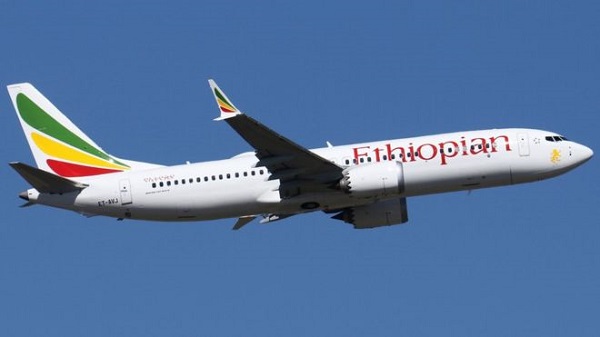The first concrete evidence of a possible link between two deadly Boeing 737 MAX crashes came from space.
A new satellite network capable of tracking planes in high fidelity across the globe captured the flight path of the Boeing Co. 737 MAX that crashed Sunday. The data was critical in persuading the U.S. to join the rest of the world in grounding the jet, according to industry and regulatory officials.
The erratic, six-minute flight of the Ethiopian Airlines plane convinced the Federal Aviation Administration that it was close enough to what preceded the Oct. 29 crash of another MAX off the coast of Indonesia to warrant concern.
After reviewing the data “it became clear — to all parties, actually — that the track of the Ethiopian Airlines flight was very close and behaved very similarly to the Lion Air flight,” agency Acting Administrator Daniel Elwell said Wednesday.
Canada’s Transport Minister Marc Garneau also cited satellite tracking on Wednesday as the reason his country joined more than 50 other nations in grounding the 737 MAX models.
The data was provided by Aireon LLC, which was formed in 2012 by Iridium Communications Inc. and Nav Canada, a nonprofit company that guides air traffic in Canada. After years of development and the launches of 66 satellites into orbit, Aireon will introduce a new commercial flight-tracking service in coming weeks.
The company shared the information with the U.S. National Transportation Safety Board and Federal Aviation Administration, as well as “several European aviation authorities and various African aviation authorities,” said Jessie Hillenbrand, an Aireon spokeswoman.
Elwell said that initial tracks of the plane available immediately after the accident by a separate company with a ground station in Ethiopia weren’t consistent with how aircraft fly and weren’t credible. However, when agency experts reviewed a refined track provided by Aireon, it raised concerns.
The Lion Air plane experienced more than two dozen sharp dips shortly after takeoff. Indonesian investigators said in a preliminary report that the plane was automatically commanded to dive because software known as Maneuvering Characteristics Augmentation System, or MCAS, thought the plane was in danger of losing lift on the wings.
Aerodynamic Stall
Boeing had added the MCAS as protection against an aerodynamic stall. However, in the case of the Lion Air flight, a malfunctioning sensor signaled that the plane was in danger when it wasn’t and it commanded unnecessary dives.
Rather than switching off the motor triggering the dives — a procedure pilots on all models of the 737 are taught to memorize — the Lion Air crew continued counteracting it with their controls until it dove into the sea.
While Elwell and Canada’s Garneau didn’t detail the Ethiopian plane’s flight path, it apparently made the same highly unusual descents followed by climbs. Normally, a jet climbs steadily after takeoff.
“It certainly puts a magnifying glass on the MCAS system,” said Peter Goelz, a former managing director at the NTSB who is now senior vice president at O’Neill & Associates, a Washington lobbying and public relations firm. “There’s an implication that there were two similar accidents and that it likely involved the interaction of the MCAS system with the flight of the aircraft.”
Kevin Durkin, an aviation lawyer, said the connection could be important in any court cases. If Boeing knew of a defect in the 737 MAX fleet, the plane manufacturer could face extra damages in lawsuits. The company’s knowledge might be demonstrated by its statements that it was making software changes after the Lion Air crash, he said.
“If you have a defective product and it turns out Boeing knew about it, this could easily expose them to punitive damages,” said Durkin, a partner at Clifford Law Offices in Chicago. The standard is whether the company engaged in conduct with a “conscious indifference to the safety of others,” he said.
Boeing has said that following longstanding procedures should prevent accidents involving MCAS failures.
On Wednesday, the Chicago-based manufacturer issued a statement saying it still has “full confidence” in the plane.
“We are supporting this proactive step out of an abundance of caution,” Boeing Chief Executive Dennis Muilenburg said in the statement, referring to the FAA action. “We are doing everything we can to understand the cause of the accidents in partnership with the investigators, deploy safety enhancements and help ensure this does not happen again.”
Elwell cautioned that there is still no definitive evidence suggesting that the two accidents are related.
The Indonesian accident investigation isn’t complete. In addition to MCAS, the preliminary report cited repeated maintenance failures and pilot performance issues. For example, the Lion Air plane suffered the same MCAS malfunction on a previous flight but it wasn’t repaired.
The Ethiopian pilots had received notice about MCAS and additional training suggested by Boeing after the Lion Air accident, Tewolde Gebre Mariam, chief executive of Ethiopian Airlines told reporters in a broadcast on state-controlled ETV.
The tracking of aircraft from space was made possible by technology designed to move away from traditional radar tracking as the U.S., Europe and other regions introduce more modern technology to their air-traffic systems. By the end of 2020, most aircraft in the U.S. will have to be equipped with devices that use GPS to calculate a plane’s position and then broadcast that and other information about the flight.
The U.S. invested more than $1 billion in building a network of ground stations that track the signals as it attempts to move to the tracking technology, known as Automatic Dependent Surveillance-Broadcast or ADS-B. That network is operated by Harris Corp., which is also a partner with Aireon.
The same data transmissions reach space only a small fraction of a second after the ground antennas and it’s what Aireon relied on to track the Ethiopian Airlines flight. A ground station operated by tracking firm FlightRadar24 captured only data from the first two minutes of the flight before the plane went out of range.
Aireon has agreements to sell its data to countries including Canada and the U.K. to track flights over the ocean, where ground-based radar doesn’t reach and planes must be kept far apart.
In addition to helping air-traffic agencies monitor flights over oceans and in countries without radar, Aireon has said the data may also assist accident investigations and help locate aircraft that crash in remote areas.
It took about two years to find an Air France plane that went down in the Atlantic in 2009, but Aireon’s data would have limited the search area to a mile or less.
“We now have a global picture of all aircraft,” Don Thoma, Aireon’s chief executive officer, said in an interview last month. “It’s finally real. It’s finally here.”
Sourcehttps://www.insurancejournal.com/news/international/2019/03/14/520598.htm














